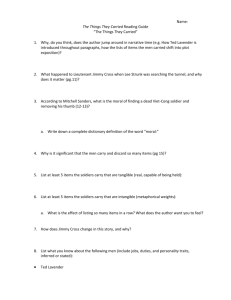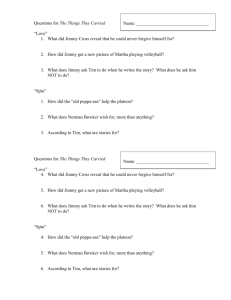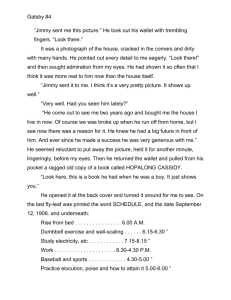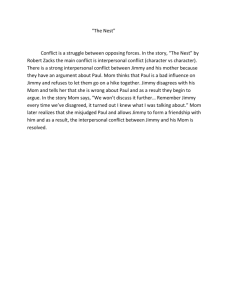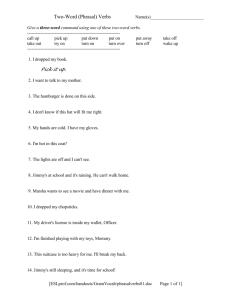Storybooks reveal early language understanding
advertisement
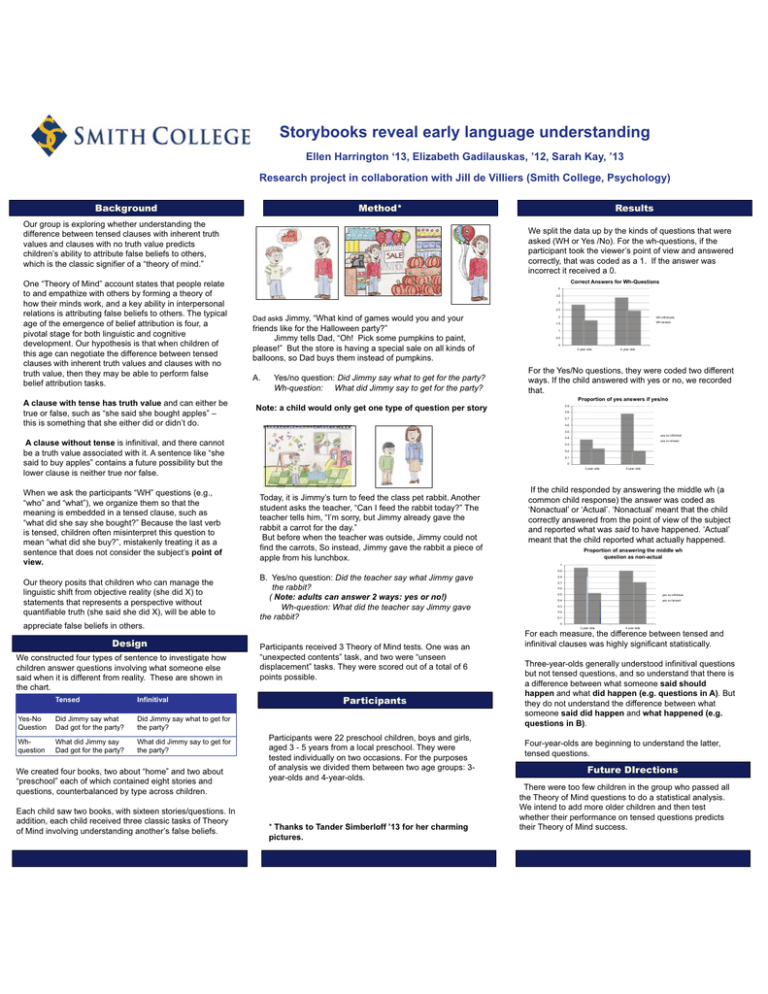
Storybooks reveal early language understanding Ellen Harrington ‘13, Elizabeth Gadilauskas, ’12, Sarah Kay, ’13 Research project in collaboration with Jill de Villiers (Smith College, Psychology) Background Method* Our group is exploring whether understanding the difference between tensed clauses with inherent truth values and clauses with no truth value predicts children’s ability to attribute false beliefs to others, which is the classic signifier of a “theory of mind.” One “Theory of Mind” account states that people relate to and empathize with others by forming a theory of how their minds work, and a key ability in interpersonal relations is attributing false beliefs to others. The typical age of the emergence of belief attribution is four, a pivotal stage for both linguistic and cognitive development. Our hypothesis is that when children of this age can negotiate the difference between tensed clauses with inherent truth values and clauses with no truth value, then they may be able to perform false belief attribution tasks. A clause with tense has truth value and can either be true or false, such as “she said she bought apples” – this is something that she either did or didn’t do. Results We split the data up by the kinds of questions that were asked (WH or Yes /No). For the wh-questions, if the participant took the viewer’s point of view and answered correctly, that was coded as a 1. If the answer was incorrect it received a 0. Correct Answers for Wh-Questions 4 3.5 3 2.5 Dad asks Jimmy, “What kind of games would you and your friends like for the Halloween party?” Jimmy tells Dad, “Oh! Pick some pumpkins to paint, please!” But the store is having a special sale on all kinds of balloons, so Dad buys them instead of pumpkins. A. Yes/no question: Did Jimmy say what to get for the party? Wh-question: What did Jimmy say to get for the party? 2 Wh infinitivals Wh tensed 1.5 1 0.5 0 3 year olds 4 year olds For the Yes/No questions, they were coded two different ways. If the child answered with yes or no, we recorded that. Proportion of yes answers if yes/no Note: a child would only get one type of question per story 0.9 0.8 0.7 0.6 0.5 yes no infinitival 0.4 A clause without tense is infinitival, and there cannot be a truth value associated with it. A sentence like “she said to buy apples” contains a future possibility but the lower clause is neither true nor false. yes no tensed 0.3 0.2 0.1 0 3 year olds When we ask the participants “WH” questions (e.g., “who” and “what”), we organize them so that the meaning is embedded in a tensed clause, such as “what did she say she bought?” Because the last verb is tensed, children often misinterpret this question to mean “what did she buy?”, mistakenly treating it as a sentence that does not consider the subject’s point of view. Today, it is Jimmy’s turn to feed the class pet rabbit. Another student asks the teacher, “Can I feed the rabbit today?” The teacher tells him, “I’m sorry, but Jimmy already gave the rabbit a carrot for the day.” But before when the teacher was outside, Jimmy could not find the carrots, So instead, Jimmy gave the rabbit a piece of apple from his lunchbox. Our theory posits that children who can manage the linguistic shift from objective reality (she did X) to statements that represents a perspective without quantifiable truth (she said she did X), will be able to B. Yes/no question: Did the teacher say what Jimmy gave the rabbit? ( Note: adults can answer 2 ways: yes or no!) Wh-question: What did the teacher say Jimmy gave the rabbit? 4 year olds If the child responded by answering the middle wh (a common child response) the answer was coded as ‘Nonactual’ or ‘Actual’. ‘Nonactual’ meant that the child correctly answered from the point of view of the subject and reported what was said to have happened. ‘Actual’ meant that the child reported what actually happened. Proportion of answering the middle wh question as non-actual 1 0.9 appreciate false beliefs in others. Design We constructed four types of sentence to investigate how children answer questions involving what someone else said when it is different from reality. These are shown in the chart. Tensed Infinitival Yes-No Question Did Jimmy say what Dad got for the party? Did Jimmy say what to get for the party? Whquestion What did Jimmy say Dad got for the party? What did Jimmy say to get for the party? We created four books, two about “home” and two about “preschool” each of which contained eight stories and questions, counterbalanced by type across children. Each child saw two books, with sixteen stories/questions. In addition, each child received three classic tasks of Theory of Mind involving understanding another’s false beliefs. 0.8 0.7 0.6 0.5 yes no infinitival 0.4 yes no tensed 0.3 0.2 0.1 0 3 year olds Participants received 3 Theory of Mind tests. One was an “unexpected contents” task, and two were “unseen displacement” tasks. They were scored out of a total of 6 points possible. Participants Participants were 22 preschool children, boys and girls, aged 3 - 5 years from a local preschool. They were tested individually on two occasions. For the purposes of analysis we divided them between two age groups: 3year-olds and 4-year-olds. * Thanks to Tander Simberloff ’13 for her charming pictures. 4 year olds For each measure, the difference between tensed and infinitival clauses was highly significant statistically. Three-year-olds generally understood infinitival questions but not tensed questions, and so understand that there is a difference between what someone said should happen and what did happen (e.g. questions in A). But they do not understand the difference between what someone said did happen and what happened (e.g. questions in B). Four-year-olds are beginning to understand the latter, tensed questions. Future DIrections There were too few children in the group who passed all the Theory of Mind questions to do a statistical analysis. We intend to add more older children and then test whether their performance on tensed questions predicts their Theory of Mind success.
